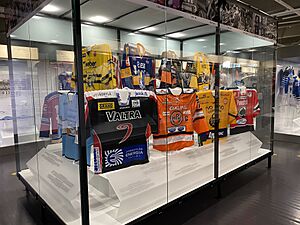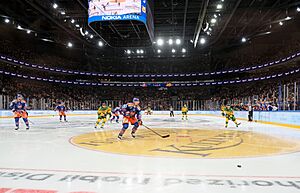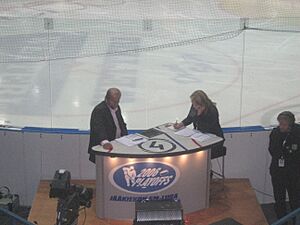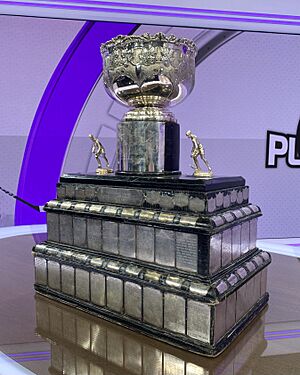Liiga facts for kids
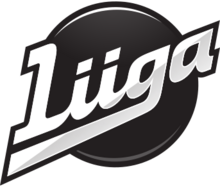 |
|
| Formerly | SM-sarja (1933–1975) SM-liiga (1975–2013) |
|---|---|
| Sport | Ice hockey |
| Founded | 1975 |
| Inaugural season | 1975–76 |
| CEO | Mikko Pulkkinen |
| Motto | Se on totta (It's for real) |
| No. of teams | 16 |
| Country | Finland |
| Most recent champion(s) |
KalPa (1st title) (2024–25) |
| Most titles | Tappara (13 titles) |
| TV partner(s) | Telia Company, TV5 |
| Level on pyramid | Level 1 |
| Relegation to | Mestis |
| International cup(s) | Champions Hockey League |
| Related competitions |
Naisten Liiga |
| Official website | Liiga.fi |
The Liiga, also known as the Finnish Elite League, is the top professional ice hockey league in Finland. It has 16 teams from all over Finland. Teams can move up to Liiga from a lower league called Mestis, or move down to Mestis from Liiga. The team that wins the Liiga playoffs each season gets a special trophy called the Kanada-malja.
Teams from the Liiga also play in an international competition called the Champions Hockey League (CHL). This competition is organized by the IIHF. Teams qualify for the CHL based on how strong their league is in Europe.
The Liiga started in 1975. It took the place of an older league called SM-sarja, which was mostly for amateur players. The Liiga is not directly managed by the Finnish Ice Hockey Association, but they work together. The letters "SM" stand for Suomen mestaruus, which means "Finnish Champion" in Finnish.
Contents
History of Liiga Hockey
The SM-liiga, which is now called Liiga, began in 1975. It replaced the older amateur league, SM-sarja. Kalervo Kummola was the first leader of the SM-liiga. He worked in that role until 1987. Unlike other leagues in Finland, the SM-liiga was not set up under the Finnish Ice Hockey Association.
The first SM-liiga season also introduced playoffs to Finnish ice hockey. This was a new and exciting way to decide the champion.
When the league first started, it had 10 teams. It grew to 12 teams in the 1988–89 season. In 2000, another team was added. After that, the league became "closed," meaning teams couldn't move up or down between leagues.
However, this changed later. For the 2005–2006 season, KalPa, a team that won the Mestis league, was allowed to join the Liiga. This happened because they met certain requirements.
The idea of teams moving up or down (promotion and relegation) came back for the 2008–09 season. But it was a bit complicated. A Mestis team that won the qualifiers had to buy shares from the Liiga team that lost. If they didn't, the losing Liiga team would stay in the league.
Starting from the 2013–2014 season, the system changed again. Now, the Mestis winner can apply for a Liiga license. If they get it, they can join the league after one transition season.
The league changed its name to just Liiga for the 2013–14 season. They also got a new logo. The 2019–20 Liiga season ended early on March 13, 2020, because of the COVID-19 pandemic. The playoffs were not played, and no champion was named that year.
For the 2024–25 season, Kiekko-Espoo joined the Liiga, making it 16 teams. Also, the system for teams moving up and down between Liiga and Mestis was fully reopened for the first time since 2013.
Experts like The Hockey Writers say that Liiga is one of the best ice hockey leagues in Europe and the world. It's often ranked highly, allowing its top teams to play in the Champions Hockey League. For the 2024–25 CHL season, Liiga was ranked the third-best league in Europe.
Liiga Teams
Meet the Clubs
The teams in Liiga usually use their traditional club names. Oy and Ab are short for "limited company" in Finnish and Swedish.
| Team name | Club's registered name | Location | Home venue | Capacity | 2024–25 Season Rank | Liiga Titles | Total Titles |
|---|---|---|---|---|---|---|---|
| HIFK | Oy HIFK Hockey Ab | Helsinki Ice Hall | 8,200 | 4th (5th) | 4 | 7 | |
| HPK | HPK Liiga Oy | Patria-areena | 5,360 | 10th (11th) | 2 | 2 | |
| Ilves | Ilves-Hockey Oy | Nokia Arena | 12,700 | 2nd (3rd) | 1 | 16 | |
| Jukurit | Jukurit HC Oy | Ikioma Areena | 4,200 | 16th (15th) | 0 | 0 | |
| JYP | JYP Jyväskylä Oy | Synergia-areena | 4,437 | 14th (did not qualify) | 2 | 2 | |
| KalPa | KalPa Hockey Oy | Olvi Arena | 5,300 | 3rd (1st) | 1 | 1 | |
| Kiekko-Espoo | Kiekko-Espoo Oy | Espoo Metro Areena | 6,982 | 8th (10th) | 0 | 0 | |
| KooKoo | KooKoo Hockey Oy | Lumon arena | 5,950 | 6th (9th) | 0 | 0 | |
| Kärpät | Oulun Kärpät Oy | Oulun Energia Areena | 6,300 | 13th (did not qualify) | 8 | 8 | |
| Lukko | Rauman Lukko Oy | Kivikylän Areena | 4,500 | 1st (4th) | 1 | 2 | |
| Pelicans | Lahden Pelicans Oy | Isku Areena | 4,403 | 15th (16th) | 0 | 0 | |
| SaiPa | Liiga-SaiPa Oy | Kisapuisto | 4,820 | 5th (2nd) | 0 | 0 | |
| Sport | Hockey-Team Vaasan Sport Oy | Vaasa Arena | 5,185 | 11th (8th) | 0 | 0 | |
| Tappara | Tamhockey Oy | Nokia Arena | 12,700 | 9th (7th) | 13 | 20 | |
| TPS | HC TPS Turku Oy | Gatorade Center | 10,500 | 12th (12th) | 10 | 11 | |
| Ässät | HC Ässät Pori Oy | Isomäki Ice Hall | 6,150 | 7th (6th) | 2 | 3 |
How Liiga Games Are Played
Regular Season Rules
- All teams play 60 games.
- Each game lasts 60 minutes.
- If the game is tied after 60 minutes, there's a 5-minute overtime period. Teams play with three players each instead of five. The first team to score wins.
- If it's still tied after overtime, there's a shootout. Each team gets three shots. If it's still tied, players take turns shooting until one scores and the other doesn't.
Scoring Points
- A win in regular time gives 3 points.
- A win in overtime gives 2 points.
- A loss in overtime gives 1 point.
- A loss in regular time gives 0 points.
- Teams are ranked by points. If teams have the same points, the one with more wins in regular time ranks higher.
Playoff Structure
- The top four teams after the regular season go straight to the quarter-finals.
- Teams ranked 5th to 12th play in preliminary playoffs. These are best-of-five series. The four winners join the quarter-finals.
- From the quarter-finals onwards, all series are best-of-seven. This means a team needs to win four games to advance.
- The teams that lose in the semi-finals play one game for a bronze medal.
- In the playoffs, the highest-ranked team plays the lowest-ranked team, and so on. Higher-ranked teams get to play more games at their home arena.
- Playoff games also have 60 minutes of regular time. If tied, they play 20-minute sudden death overtime periods with five players each. The first team to score wins.
Relegation Explained
- The teams finishing 15th and 16th play a special series called a "playout."
- The loser of this playout series then plays against the champion of the Mestis league. This decides which team plays in Liiga next season.
Season Schedule
- The regular season usually starts in mid-September.
- There's a short break in late October/early November for the Karjala Tournament, where Team Finland plays.
- There's also a one-week break for Christmas.
- In years when the Winter Olympic Games happen, there's a break for that too.
- The regular season ends around mid-March, and playoffs start right away.
- The playoffs finish by mid-April, so players can join their national teams for the World Championships.
Liiga Champions
The team that wins the playoffs gets gold medals and the Kanada-malja trophy. This is the most important trophy in Liiga. The team that finishes first in the regular season also gets a trophy, the Harry Lindbladin muistopalkinto. However, winning the playoffs and the Kanada-malja is considered a bigger achievement.
Past Champions
- 1976 – TPS
- 1977 – Tappara
- 1978 – Ässät
- 1979 – Tappara
- 1980 – HIFK
- 1981 – Kärpät
- 1982 – Tappara
- 1983 – HIFK
- 1984 – Tappara
- 1985 – Ilves
- 1986 – Tappara
- 1987 – Tappara
- 1988 – Tappara
- 1989 – TPS
- 1990 – TPS
- 1991 – TPS
- 1992 – Jokerit
- 1993 – TPS
- 1994 – Jokerit
- 1995 – TPS
- 1996 – Jokerit
- 1997 – Jokerit
- 1998 – HIFK
- 1999 – TPS
- 2000 – TPS
- 2001 – TPS
- 2002 – Jokerit
- 2003 – Tappara
- 2004 – Kärpät
- 2005 – Kärpät
- 2006 – HPK
- 2007 – Kärpät
- 2008 – Kärpät
- 2009 – JYP
- 2010 – TPS
- 2011 – HIFK
- 2012 – JYP
- 2013 – Ässät
- 2014 – Kärpät
- 2015 – Kärpät
- 2016 – Tappara
- 2017 – Tappara
- 2018 – Kärpät
- 2019 – HPK
- 2020 – Cancelled because of the Coronavirus pandemic
- 2021 – Lukko
- 2022 – Tappara
- 2023 – Tappara
- 2024 – Tappara
- 2025 – KalPa
Top Players in Liiga History
These tables show some of the best players in Liiga's regular season history. The numbers are updated after each season.
Top 10 Regular Season Scorers (Finnish Players)
This list shows players who have scored the most points (goals + assists). Note: Pos = Position; GP = Games Played; G = Goals; A = Assists; Pts = Points
| Player | Pos | GP | G | A | Pts |
| Janne Ojanen | C | 876 | 283 | 516 | 799 |
| Arto Javanainen | C | 688 | 462 | 330 | 792 |
| Ville Vahalahti | LW | 977 | 260 | 427 | 687 |
| Kristian Kuusela | LW | 1107 | 280 | 458 | 738 |
| Jari Lindroos | C | 649 | 230 | 432 | 662 |
| Esa Keskinen | C | 478 | 215 | 443 | 658 |
| Matti Hagman | C | 432 | 217 | 432 | 649 |
| Risto Jalo | C | 594 | 275 | 409 | 646 |
| Juha-Pekka Haataja | RW | 881 | 256 | 326 | 582 |
| Raimo Helminen | C | 751 | 161 | 420 | 581 |
Top 10 Regular Season Scorers (Import Players)
This list shows players from other countries who have scored the most points. Note: Pos = Position; GP = Games Played; G = Goals; A = Assists; Pts = Points
| Player | Pos | GP | G | A | Pts |
| Éric Perrin | C | 643 | 189 | 343 | 532 |
| Otakar Janecký | C | 450 | 133 | 346 | 479 |
| Aleksandr Barkov | LW | 518 | 135 | 281 | 416 |
| Darren Boyko | C | 476 | 171 | 236 | 407 |
| Jan Čaloun | RW | 298 | 145 | 230 | 375 |
| Vjačeslavs Fanduļs | C | 476 | 148 | 211 | 359 |
| Tomáš Záborský | C | 468 | 170 | 182 | 352 |
| Allan Measures | D | 619 | 100 | 238 | 338 |
| Shayne Toporowski | RW | 464 | 135 | 185 | 320 |
| Stefan Öhman | C | 419 | 104 | 160 | 264 |
Top 10 Regular Season Games Played (Goaltenders)
This list shows the goaltenders who have played the most regular season games.
| Player | GP |
| Eero Kilpeläinen | 518 |
| Pasi Kuivalainen | 517 |
| Jukka Tammi | 510 |
| Sakari Lindfors | 471 |
| Jussi Markkanen | 471 |
| Hannu Kamppuri | 460 |
| Ari-Pekka Siekkinen | 447 |
| Mika Lehto | 404 |
| Petri Vehanen | 399 |
| Teemu Lassila | 388 |
Liiga Trophies
The Liiga gives out many awards each season to recognize great players, coaches, and referees. In 1995, these trophies were named after famous Finnish hockey legends.
- Harry Lindblad memorial trophy – Awarded to the team that wins the regular season.
- Kultainen kypärä – Given to the best player, as voted by other Liiga players.
- Kalevi Numminen trophy – Awarded to the best coach.
- Jarmo Wasama memorial trophy – Given to the best new player (rookie) of the year.
- Matti Keinonen trophy – For the player with the best plus/minus rating (most effective player).
- Raimo Kilpiö trophy – For the player who plays fairly and is the most gentlemanly.
- Urpo Ylönen trophy – Awarded to the best goaltender.
- Pekka Rautakallio trophy – For the best defenseman.
- Aarne Honkavaara trophy – For the player who scores the most goals in the regular season.
- Veli-Pekka Ketola trophy – For the player who gets the most points (goals + assists) in the regular season.
- Lasse Oksanen trophy – For the best player during the regular season.
- Jari Kurri trophy – For the best player during the playoffs.
- Unto Wiitala trophy – For the best referee during the regular season.
- Pentti Isotalo trophy – For the best linesman during the regular season.
- Golden whistle trophy – For the best referee of the year, voted by the players.
Liiga in Video Games
You can play with teams from the Liiga in some video games! They first appeared in NHL 2001 and have been in EA Sports' NHL series since NHL 2004.
See also
 In Spanish: Liiga para niños
In Spanish: Liiga para niños
- List of SM-liiga seasons
- List of Finnish ice hockey champions
- Mestis
- Naisten Liiga
- SM-sarja
- Ice hockey in Finland
- Leijonat


